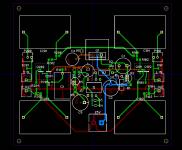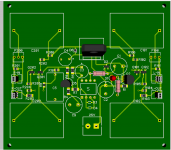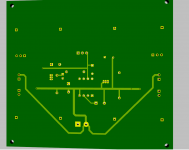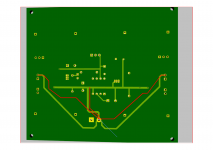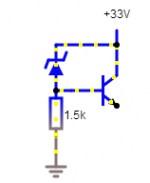Well, the electron drift velocity in copper is in the order of 20 µm/s...
Quite a lot amount of time to take a 90 degree turn - don't you thing so, too?
Electric field, Poynting vector and the like might be other story.
Ulli ,-)
🙂
Well, I always try to make it compact, but that's just me. Not a big deal I think.
What I do is step back, look at the big picture, forget about all the parts and stuff, just look at the pattern. But I've been doing that for decades I guess ;-)
Jan
What I do is step back, look at the big picture, forget about all the parts and stuff, just look at the pattern. But I've been doing that for decades I guess ;-)
Jan
Attachments
Last edited:
In a scale of 1-10 , how does this design appear to you , I have not much experience in this. So any feed back is appreciated. What are the positives and negatives?
I left some space to desolder in future.
I left some space to desolder in future.
For me it is pretty good. It's just that I've done it so often, things spring out to me instantly.
But yours is fine.
Jan
But yours is fine.
Jan
Thanks Jan, I feel confident with sending it to a PCB place, likey this week. Before that I will make change for ground traces you suggested.
How confident are you that the PCB conforms to the schematic? Was there a netlist link between schematic and PCB layout?
Jan
Jan
here is the schematic,and pdf attached.I uses diptrace and it compares schematic with pcb
Attachments
Last edited:
I have a superreg built which I have set to 17V output. Unfortunately I only have a 24V transformer I want to use for this project. So I need to drop 15V or so...
This is feeding a Preamp at 400ma or so for both channels.
Bad idea to drop 15V at 400ma? Heatsinks are regular 54mm tall to-220.
This is feeding a Preamp at 400ma or so for both channels.
Bad idea to drop 15V at 400ma? Heatsinks are regular 54mm tall to-220.
Or I suppose I could use a big resistor in the cap bank before the regulator. CRC style...
Don't know which way would sound better. Maybe I should just buy an 18v transformer.
Don't know which way would sound better. Maybe I should just buy an 18v transformer.
Are you ruling out surface mount for the op-amp? AD825 is only in surface mount.how does this design appear to you
An L-pad can sound better than a pot. The series element is a resistor and the nasty sounding pot is only shunting to earth. I just did a couple of conversions like that, with something like a 2 k or 5k in the signal path, followed by the 50k pot, in those cases, to earth, and wiper to earth. Then your 1k.
You have R202 after the capacitor C201 (200 on the original schematic), and after R206 (which was 203 on the original), instead of before them. Or is that a gate resistor for each FET? Which the pdf doesn't have: http://www.firstwatt.com/pdf/prod_b1_man.pdf Or are you earthing the lower FET's gate via a resistor?
Should the input and output grounds not be separate to the earth star?
Copper track sound muffled and blurred so the less of it in the signal path the better. Same for solder joints. I would try and share solder pads to reduce the number of joints. I done these things many times and heard the extra clarity.
Last edited:
The more I look at it, the less it makes sense! It would help if all the component numbers aligned with the original schematic. Why is the output of Q1 going to D6? And then on to the signal traces from the input capacitors via those two resistors?
Does any one know how the pefromance of this compares with lm317 337?
Partly here: Downloads | Linear Audio
scroll down to 'Color graphs for Jack Walton's regulator article in Vol 4'
Then there's the full article at Linear Audio | your tech audio resource
Jan
.. . the nasty sounding pot ...
...Copper track sound muffled and blurred
You crack me up!
Jan
Super Regulator – diyAudio Store
I mean when I click link for measurements it tells you to look for vol 4, but you have to buy vol4 to see the actuall performance of the "super regulator".
If I was a customer, I would not consider this product because there are no specification on ripple rejection.
The output dosen't seem to be short protected either.
LM317 has good ripple rejection and is short proof. Is there any reason for me to consider this regulator over it? It also consumes much less components.
I mean when I click link for measurements it tells you to look for vol 4, but you have to buy vol4 to see the actuall performance of the "super regulator".
If I was a customer, I would not consider this product because there are no specification on ripple rejection.
The output dosen't seem to be short protected either.
LM317 has good ripple rejection and is short proof. Is there any reason for me to consider this regulator over it? It also consumes much less components.
I have a superreg built which I have set to 17V output. Unfortunately I only have a 24V transformer I want to use for this project. So I need to drop 15V or so...
This is feeding a Preamp at 400ma or so for both channels.
Bad idea to drop 15V at 400ma? Heatsinks are regular 54mm tall to-220.
You can drop your voltage by a zener refrence connected to base of a power transistor mounted on a sensible heat sink. power disipated would be VCC-zener voltage -0.6 times current drawn.
Required zener bias current would be output current divided by gain of transistor.
This circuit its self can regulate +- volts with moderate regulation performance.
You can then feed this into your super regulator, which means your doubble regulating your voltage and it will be extremely smooth
The circuit in picture will work as long as gain is 100 or bigger, zener value would be half watt and resistor half watt. You connect the load directly accross emitter and ground.
Most transistors should have gain of more than 100.
EDIT: large caps can be added to the zener and resistor connected to base for extra regulation.
Emitter should also have a some sort of capacitance 10UF or larger when you want more regulation
Attachments
Last edited:
"If I was a customer, I would not consider this product because there are no specification on ripple rejection."
Use whatever you like and whatever makes you feel the most comfortable. Some people like the uA723 IC regulator {used in Nelson Pass's first preamp, the Threshold NS-10}. Others like the LM317. Others like the Jung/Didden "Super Regulator". Others (such as myself!) prefer to design and build our own regulator from scratch. Here is mine from October 2015 -- beware, its design and troubleshooting should only be attempted by folks with a university degree in EE -- but you can view it for free. Still others like to build shunt-mode voltage regulators; there is a very popular design here that "Search" will find when you seek "Simplistic Salas Shunt". Modernists prefer the all-SMD "SilentSwitcher" (I bought two of them!). And of course there are the multi-stage regulators such as the Jung "preregulator" upstream of the "Super Regulator", the "Super Teddy", John Curl's nosebleed high end designs using 1st_stage_series_reg followed by 2nd_stage_shunt_reg, and so forth. One highly regarded "Stereophile Class A" phonostage uses a seven section RC passive filter cascade at the input of the voltage regulator. Nothing is too weird for somebody to try!
Everybody has their own tastes, and as a result there are a LARGE number of well-loved regulator designs, all of them different.
Use whatever you like and whatever makes you feel the most comfortable. Some people like the uA723 IC regulator {used in Nelson Pass's first preamp, the Threshold NS-10}. Others like the LM317. Others like the Jung/Didden "Super Regulator". Others (such as myself!) prefer to design and build our own regulator from scratch. Here is mine from October 2015 -- beware, its design and troubleshooting should only be attempted by folks with a university degree in EE -- but you can view it for free. Still others like to build shunt-mode voltage regulators; there is a very popular design here that "Search" will find when you seek "Simplistic Salas Shunt". Modernists prefer the all-SMD "SilentSwitcher" (I bought two of them!). And of course there are the multi-stage regulators such as the Jung "preregulator" upstream of the "Super Regulator", the "Super Teddy", John Curl's nosebleed high end designs using 1st_stage_series_reg followed by 2nd_stage_shunt_reg, and so forth. One highly regarded "Stereophile Class A" phonostage uses a seven section RC passive filter cascade at the input of the voltage regulator. Nothing is too weird for somebody to try!
Everybody has their own tastes, and as a result there are a LARGE number of well-loved regulator designs, all of them different.
- Home
- The diyAudio Store
- Super Regulator
